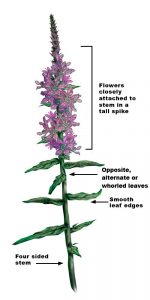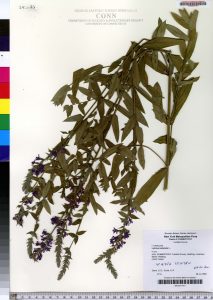This exercise, developed by Jon Swanson of E.O. Smith High School in Storrs, concerns invasive species. A pdf version of this activity is available here.

The United States Department of Agriculture National Invasive Species Information Center defines invasive species as “‘an alien species whose introduction does or is likely to cause economic or environmental harm or harm to human health’ in Executive Order 13112: Section1. Definitions.”
Scientists have become very interested in the impact that invasive species have on the environments into which they are introduced. One of the problems in studying these species is that it can be difficult to determine when and where these species were introduced. It also can be difficult to track their spread across the landscape. The good news is that scientists have a tool to help them study invasive species — online plant collection databases.
The University of Connecticut houses the George Safford Torrey Herbarium, which is a collection of more than 200,000 specimens collected from the 1800s up to the present. They have been collected by hundreds of people from all over New England and the world and can be a useful resource for a biologists looking into the plants of the area.
What do you think?
– What types of questions might a scientist have about invasive species?
– What type of information might an herbarium collection provide to help a scientist studying an invasive species?
Now let’s take a look!
For this activity you will be looking at Purple Loosestrife (Lythrum salicaria), a particularly aggressive invasive species that has gained much notoriety in the media.
Instructions:
1. Go to the site for the CONN Herbarium Simple Search page at: https://search.biodiversity.uconn.edu/SimpleSearch.html
2. Enter the scientific name of the species (you MUST spell it correctly) into the query box on the site and press the “Submit” button. This will search the entire database of the herbarium collection for specimens of that species that are stored there.
3. The results of your search will be brought up as a series of individual records. What types of information are given for each record?

4. At the top of the list is a link for “Map these results in Berkeley Mapper.” Click on this link and you will get the same results plotted out on a world map. Each blue dot on the map represents a locality with 1-9 specimen records in the database; yellow dots indicate localities with 10-99 specimen records, and red dots indicate localities with more than 100 specimen records. Double-click or use the “+” button at top left to zoom in, and single-click to drag the map so you can view the northeastern United States.
5. Click the polygon button at the top of the map to switch from the hand pointer to the “draw a shape” pointer. Use this tool to draw a shape encompassing all records from Connecticut north to the Canadian border. When you close the shape (make your last point meet your first point), a note will pop up with some statistics. Click on “Query Points Inside.” Click on that link and it will open a table at the bottom of the map with the details for each of the records listed on the map. You can use your mouse to pull the top of the table upwards to reveal multiple records.
6. The data table is sortable based on any of the fields shown. Start by sorting the data based on the date of collection by clicking the up arrow next to Year column heading. This will arrange the specimens based on the date the specimen was collected from oldest to newest.
– What is the oldest specimen of Purple Loosestrife held at CONN?
– Where was it collected?
7. Purple loosestrife is thought to have been introduced into the United States sometime in the early 1800s. One potential application of the specimens in the herbarium collection is to use them to track the spread of Purple Loosestrife in the past. To do that, the data need to be sorted out.
Use the data from your query to fill in the following chart:
| Years | Number of Records |
| 1890-1900 | |
| 1901-1910 | |
| 1911-1920 | |
| 1921-1930 | |
| 1931-1940 | |
| 1941-1950 | |
| 1951-1960 | |
| 1961-1970 | |
| 1971-1980 | |
| 1981-1990 | |
| 1991-2000 | |
| 2001-2010 | |
| 2011-2020 |
Now graph your data in the space provided:
– What do your data suggest about the frequency of Purple Loosestrife as time passed?
8. Tracking the spread of an invasive species also can be done by looking at some of the other data that is provided by the herbarium records as well.
Leave your data in chronological order and use the data from specimens collected in Connecticut to fill in the following data tables:
| Connecticut county | Year of 1st record | Year for multiple records |
| Litchfield | ||
| Hartford | ||
| Fairfield | ||
| New Haven | ||
| New London | ||
| Tolland | ||
| Middlesex | ||
| Windham |
| Year | Number of counties with records | Number of counties with multiple records |
| 1896 | ||
| 1898 | ||
| 1904 | ||
| 1910 | ||
| 1915 | ||
| 1928 | ||
| 1931 | ||
| 1932 | ||
| 1940 | ||
| 1943 | ||
| 1966 | ||
| 1976 |
– According to the database, about how many years from the first record until Purple Loosestrife had spread throughout the state of Connecticut?
– Why is the year for multiple records significant in this type of study?
9. Another possible application of the herbarium database is to determine some information about a plant of interest. Using the mapping program, click on one of the yellow dots in Connecticut and look at the locality information that is displayed in the data table below the map.
– What do all of the specimens have in common in terms of the environment in which they were collected?
Think about it…
– What are some of the limitations of using this data base as a tool to track the spread of Purple Loosestrife?
– What other questions could a biologist answer about a species based on the specimens cataloged at the Torrey Herbarium collection?
10. Using the information from the Purple Loosestrife investigation that you just completed, create an informational pamphlet on the history of Purple Loosestrife in Connecticut. Your pamphlet should describe the spread of Purple Loosestrife through Connecticut over time. Include the trends that you saw in your herbarium collection searches along with information on the introduction of Loosestrifeto the U.S. and the role of Loosestrife in the environment. You will need to do some research to find this information! Also include pictures of the species in the pamphlet.
Your grade on the pamphlet will be based on:
-Inclusion of the information that you gained from the herbarium search
-Information on the introduction and role of Purple Loosestrife
-Photos/drawings of Purple Loosestrife
-Neatness
-Citations of sources you use
See the accompanying rubric for more information on grading.